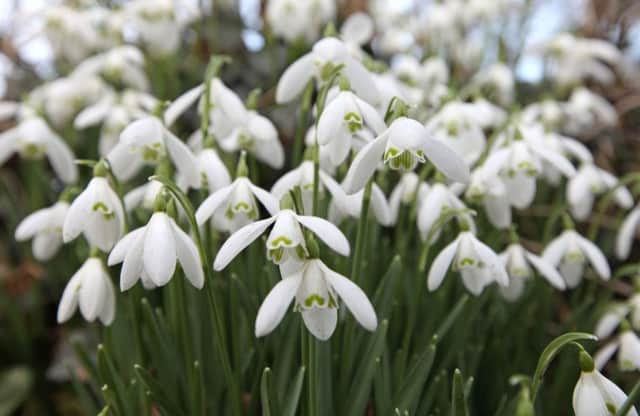Sensational snowdrops are all set to spring into bloom


More than 80 gardensin Britain will open their gates for the National Gardens Scheme snowdrop festival during February, some growing as many as 300 different varieties, others mixing the displays with hellebores and early spring flowers (www.ngs.org.uk).
Meanwhile, the National Trust also has a raft of gardens at which you can see snowdrops in all their glory, some of which feature snowdrop weekends, festivals and other attractions (www.nationaltrust.org.uk).
Advertisement
Hide AdAdvertisement
Hide AdHere are just a few of the places you can go to see snowdrops at their finest:
Newham Park, Gloucestershire
Visitors can enjoy the park’s Spectacular Snowdrop Weekend on February 4 and 5, when snowdrop drifts mingle with aconites and cyclamen to give an impressive show (www.nationaltrust.org.uk/newark-park).
Austwick Hall, near Settle, North Yorkshire
Set in the dramatic limestone scenery of the Dales, this garden on a steep hillside offers extensive drifts of common single and double snowdrops, while sculptures along the trail add interest. As part of the National Gardens Scheme, in which owners open their gardens to raise money for nursing and caring charities, Austwick will open on Wednesday, February 22. Further open days are on February 12, 13, 19, 20, 26 and 27 (www.austwickhall.co.uk).
Dunham Massey, Cheshire
The seven-acre winter garden at Dunham Massey is the largest of its kind in the UK. Since it opened in 2009, more than 200,000 double and single snowdrops have been planted, which now create a shimmering white carpet from late December to early February. Keep an eye out for other early spring flowers while you’re there, including striking blue winter irises and bright daffodils (www.nationaltrust.org.uk/dunham-massey).
Altamont Gardens, Co. Carlow
Advertisement
Hide AdAdvertisement
Hide AdIt’s Snowdrop Week from Feb 6-14 at Altamont, which houses a blend of formal and informal gardens with riverside walks covering more than 40 acres. The estate gains much of its character from the many mature trees and woodland areas. The snowdrop collection, widely recognised as the second largest in Ireland, was started by Corona North, former owner of the gardens, around 30 years ago and now has more than 100 named varieties (www.carlowtourism.com/altamont-gardens).
Saltram, Devon
Standing high above the River Plym with magnificent views across the estuary, Saltram’s 500 acres of rolling parkland and woodland provide the perfect setting for a stunning snowdrop display. As the snowdrops frame the pathways, take a stroll and explore the tranquil garden, 18th century orangery and magnificent lime avenue. Bring the whole family back in February to plant your own snowdrops with the garden team (www.nationaltrust.org.uk/saltram).
Castle Kennedy Gardens, Stranraer
Enjoy the beautiful swathes of snowdrops and spring bulbs on the woodland walks and lochside drives during the Snowdrop Festival every weekend from February 4 to March 26 at Castle Kennedy Gardens. Created in the 16th century and extensively landscaped with terraces, mounds and avenues, the gardens now encompass more than 75 acres and house spectacular collections of rhododendrons and champion trees (castlekennedygardens.com).
Dudmaston Estate, Shropshire
This beautiful 17th century house with wooded parkland and sweeping gardens will be holding snowdrop weekends on February 18-19 and 25-26. Enjoy a family walk through the Dingle where the snowdrops will be in full bloom (www.nationaltrust.org.uk/dudmaston).
Wallington, Northumberland
Advertisement
Hide AdAdvertisement
Hide AdFor the past two years, visiting families have planted more than 200,000 snowdrops at Wallington, and a further 100,000 will be planted this February half-term. As well as the common variety, Wallington’s snowdrop display includes a few specials. The less common varieties include the Northumbrian ‘Sandersii’ group which has sulphur-yellow markings instead of green, and the pretty ‘Flore Pleno’ with double the number of petals. Open from February 13 (www.nationaltrust.org.uk/wallington).
GROW YOUR OWN
If you want to naturalise your own collection of snowdrops, you’ll have to plant an awful lot to achieve the effect quickly. They are so small – planting 100 has little effect – so the best course of action is to plant as many as you can each year, so your snowdrop colony gradually spreads.
Snowdrops like semi-shade and moist soil, rich in organic matter. Plant them in groups of 10 or more in autumn, spacing them 4cm apart and 7cm deep, which may seem thin on the ground the first year, but gives them time to multiply and spread.
They can be naturalised in grass, but if you want extensive colonies, you’ll have to allow them to set seed before you cut the grass, and the foliage and flower stems must have died back completely before you mow.
Advertisement
Hide AdAdvertisement
Hide AdAmong the best for naturalising are Galanthus nivalis, probably the easiest to grow, G. nivalis ‘Flore Pleno’, the double snowdrop, and G. elwesii, which has larger flowers than the others and tolerates drier conditions.